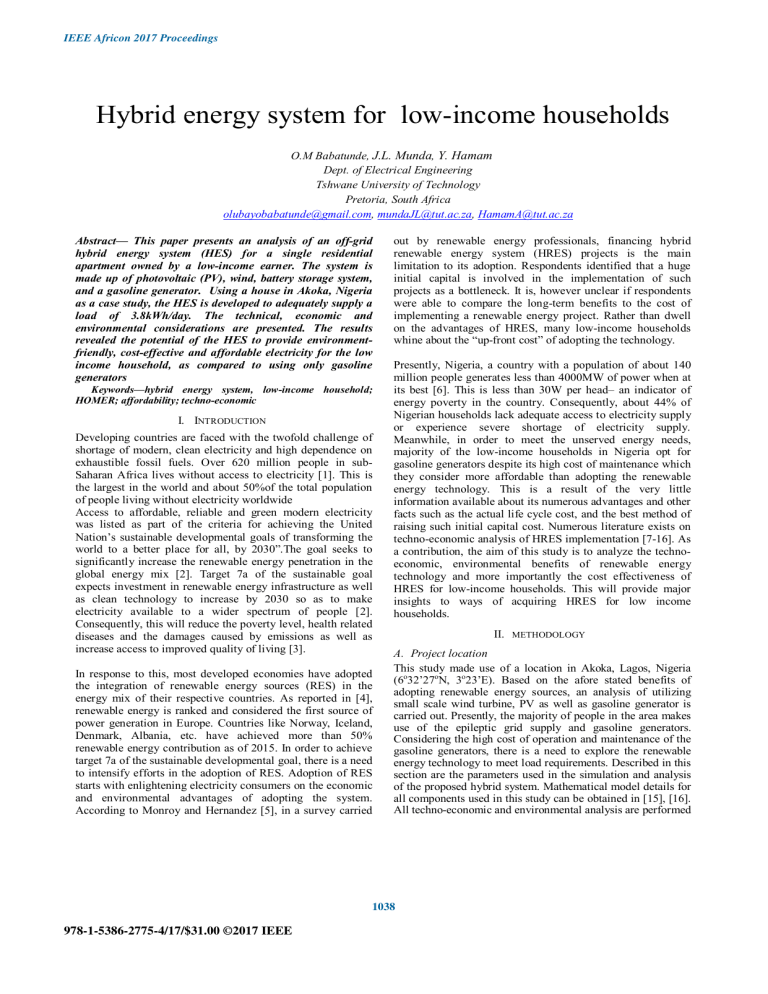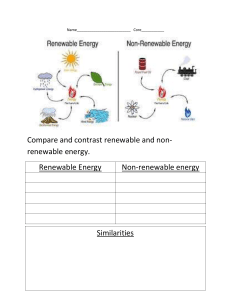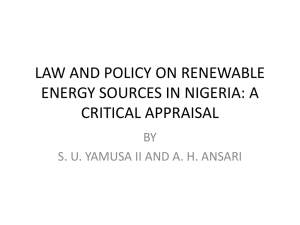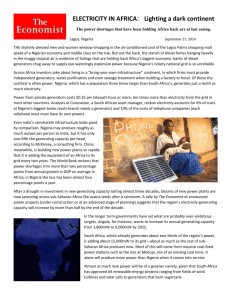
IEEE Africon 2017 Proceedings Hybrid energy system for low-income households O.M Babatunde, J.L. Munda, Y. Hamam Dept. of Electrical Engineering Tshwane University of Technology Pretoria, South Africa olubayobabatunde@gmail.com, mundaJL@tut.ac.za, HamamA@tut.ac.za Abstract— This paper presents an analysis of an off-grid hybrid energy system (HES) for a single residential apartment owned by a low-income earner. The system is made up of photovoltaic (PV), wind, battery storage system, and a gasoline generator. Using a house in Akoka, Nigeria as a case study, the HES is developed to adequately supply a load of 3.8kWh/day. The technical, economic and environmental considerations are presented. The results revealed the potential of the HES to provide environmentfriendly, cost-effective and affordable electricity for the low income household, as compared to using only gasoline generators Keywords—hybrid energy system, low-income household; HOMER; affordability; techno-economic I. INTRODUCTION Developing countries are faced with the twofold challenge of shortage of modern, clean electricity and high dependence on exhaustible fossil fuels. Over 620 million people in subSaharan Africa lives without access to electricity [1]. This is the largest in the world and about 50%of the total population of people living without electricity worldwide Access to affordable, reliable and green modern electricity was listed as part of the criteria for achieving the United Nation’s sustainable developmental goals of transforming the world to a better place for all, by 2030”.The goal seeks to significantly increase the renewable energy penetration in the global energy mix [2]. Target 7a of the sustainable goal expects investment in renewable energy infrastructure as well as clean technology to increase by 2030 so as to make electricity available to a wider spectrum of people [2]. Consequently, this will reduce the poverty level, health related diseases and the damages caused by emissions as well as increase access to improved quality of living [3]. In response to this, most developed economies have adopted the integration of renewable energy sources (RES) in the energy mix of their respective countries. As reported in [4], renewable energy is ranked and considered the first source of power generation in Europe. Countries like Norway, Iceland, Denmark, Albania, etc. have achieved more than 50% renewable energy contribution as of 2015. In order to achieve target 7a of the sustainable developmental goal, there is a need to intensify efforts in the adoption of RES. Adoption of RES starts with enlightening electricity consumers on the economic and environmental advantages of adopting the system. According to Monroy and Hernandez [5], in a survey carried out by renewable energy professionals, financing hybrid renewable energy system (HRES) projects is the main limitation to its adoption. Respondents identified that a huge initial capital is involved in the implementation of such projects as a bottleneck. It is, however unclear if respondents were able to compare the long-term benefits to the cost of implementing a renewable energy project. Rather than dwell on the advantages of HRES, many low-income households whine about the “up-front cost” of adopting the technology. Presently, Nigeria, a country with a population of about 140 million people generates less than 4000MW of power when at its best [6]. This is less than 30W per head– an indicator of energy poverty in the country. Consequently, about 44% of Nigerian households lack adequate access to electricity supply or experience severe shortage of electricity supply. Meanwhile, in order to meet the unserved energy needs, majority of the low-income households in Nigeria opt for gasoline generators despite its high cost of maintenance which they consider more affordable than adopting the renewable energy technology. This is a result of the very little information available about its numerous advantages and other facts such as the actual life cycle cost, and the best method of raising such initial capital cost. Numerous literature exists on techno-economic analysis of HRES implementation [7-16]. As a contribution, the aim of this study is to analyze the technoeconomic, environmental benefits of renewable energy technology and more importantly the cost effectiveness of HRES for low-income households. This will provide major insights to ways of acquiring HRES for low income households. II. A. Project location This study made use of a location in Akoka, Lagos, Nigeria (6o32’27oN, 3o23’E). Based on the afore stated benefits of adopting renewable energy sources, an analysis of utilizing small scale wind turbine, PV as well as gasoline generator is carried out. Presently, the majority of people in the area makes use of the epileptic grid supply and gasoline generators. Considering the high cost of operation and maintenance of the gasoline generators, there is a need to explore the renewable energy technology to meet load requirements. Described in this section are the parameters used in the simulation and analysis of the proposed hybrid system. Mathematical model details for all components used in this study can be obtained in [15], [16]. All techno-economic and environmental analysis are performed 1038 978-1-5386-2775-4/17/$31.00 ©2017 IEEE METHODOLOGY IEEE Africon 2017 Proceedings by HOMER based on these mathematical models. It is important to state that though Lagos state, Nigeria was selected as the study site, the methodology of this research can be reproduced globally. B. Renewable energy resources The solar and wind resources for Akoka was retrieved from NASA website [17]. Fig.1 shows the average monthly solar radiation and the clearness index for the site. The annual scaled average value is 4.69 kWh/m2/day. The lowest and the highest radiance occurred in August and February respectively. A chart showing the monthly average values of wind speed related to the case study location is given in Fig. 2. It is evident from this figure, that the minimum speed of 2.8 m/s is experienced in October and maximum of 4.3 m/s in February. The average wind speed for the whole year is 3.5 m/s. Global Horizontal Radiation 1.0 5 0.8 0.6 3 0.4 2 0.2 1 0 energy demand (kWh) 4 Clearness Index Daily Radiation (kWh/m²/d) 6 (electricity consumption) will be minimal during this period. Appliances such as iron and fridge operate intermittently for a few minutes during the night. The two fans only operate concomitantly from 8 pm-10 pm after which one is switchedoff. Except for the pressing iron, it is assumed that all appliances in use are energy efficient and consume less energy. It is also worth noting that the load model is analysed based on the dry season demand. The utilisation of energy in Nigerian households is at the peak in the dry season because of the demand for adequate cooling and ventilation. For the load model in this study, the demand peaks between 4 am and 6am as people prepare to go to work and also between 8 pm and 10 pm (as people retire from work) after which it drops as the consumer goes to bed. The demand by individual appliance is estimated for 24 hours and its cumulative value is estimated. In order to obtain the annual load, HOMER was used to obtain the load profile. The daily demand and power are 3.8 kW h/d and 874 W at peak respectively. Fig 3 shows the load profile of a typical low-income household. Jan Feb Mar Apr May Jun Daily Radiation Fig. 1 Jul Aug Sep Oct Nov Dec 0.0 Clearness Index Average monthly solar radiation and the clearness index for Akoka Wind Resource 3.5 0.6 0.5 0.4 0.3 0.2 0.1 0 0 W i n d S p e e d (m /s ) 3.0 2 4 6 8 10 12 14 16 18 20 22 hour of the day 2.5 Fig. 3. 2.0 1.5 1.0 0.5 0.0 Fig. 2 Jan Feb Mar Apr May Jun Jul Aug Sep Oct Nov Dec Monthly average wind speed for Akoka C. Load profile In this study, it is assumed that the consumers are junior staffs of the University of Lagos, Nigeria. Junior staffs are usually considered as low-income earners. The 24-hour load demand for a typical low-income household is shown in Fig. 3. This was estimated based on the various appliances (television, iron, fan, lamp and fridge) as shown in Table 1. It is also assumed that the occupant will be away from home on weekdays between 8 am – 6 pm which implies that demand 24-hour energy demand for a typical low-income earner household D. Other input parameters Based on the solar and wind resource available at the study site, the proposed hybrid system will be a combination of the PV array, wind turbines, diesel generators and storage batteries. Fig. 4 shows the schematics for the possible configuration and individual components. Final configuration and actual sizes, is decided after performing optimization. Multiple solution candidate values and other requirements are entered into HOMER. The PV module technical parameters used here are as presented in [15] and the economic details of the components are presented in Table 3. Economic values are based on the literature as well as the dollar equivalent of market prices [3], [15]. A 12% annual real interest rate was applied. 1039 IEEE Africon 2017 Proceedings TABLE 1. TYPICAL APPLIANCE RATING AND LOAD DEMAND FOR LOW-INCOME HOUSEHOLDS Qty Television Iron Fan Lamps Fridge Others 1 1 2 6 1 Power (W) Total power (W) Daytime hours (07:00–17:59) Evening hours (18:00–21:59) Night hours (22:00–06:59) Total Hours/day Total energy (kWh/day) 65 1000 65 18 65 50 65 1000 130 108 65 50 0 0 0 3 1 0 5 0.17 3 3 1 3 0 0 9 2 4 2 5 0.17 12 8 6 5 0.33 0.17 0.98 0.59 0.39 0.25 TABLE 2. COMPONENT DATA Cost Component ($/kW) Replacement cost ($/kW) Operation & maintenance cost Sizes consider Life span PV 4250 4200 0$/yr 0-5kW 20yrs Battery (4V,1900Ah) 269 260 5$/yr 0,6,12,18,24,32,40 (No) 4yrs Converter 622 569 3$/yr 0,1,2,3,4 (kW) 15yrs Gasoline Gen. (2.6kW) 900 900 0.04$/hr 0.4,0.5,0.75 (kW) 15,000hrs Wind turbine (3kW DC) 1200 1100 20/yr 0,1,3 (No) 15yrs III. RESULTS AND DISCUSSION A. Techno-economic A system configuration of 1kW PV, 400W gasoline generator, 6 batteries and 1kW converter would be the most economically feasible with a minimum total net present cost of $4654 and cost of energy of $0.442/kWh. Its initial setup cost is $2682 while its renewable fraction is 98% of the total energy production. Consumers using this architecture would only need to run the gasoline generator for 121 hours annually as compared to 4745 hours if only gasoline generator is used. The system with the lowest initial capital cost is the gasoline generator only system which requires $288 for setup. This system incurs the second highest operating cost of $655 annually. This in turn increases its TNPC and it is estimated as $7285. This is approximately 56% higher than the most economically viable system. The most expensive option for generation is the wind-battery system with 2 wind turbines, 32 batteries and 1 kW inverter. The capital cost for this system is $14, 923, TNPC of $22,842, COE of 2.17$/yr and RF of 100%. Other economic metrics are given in Table 3. When the optimal system is compared with the generator only system, a simple payback period and discounted payback period of 4.05 years and 4.96 years respectively is achievable. consumed by the generator. This information is then employed to estimate the quantity of emissions produced by the generator. Various values of CO 2 emission factors were reported in [15]; 3.20, 3.15 and 3.00 kg CO2 per litre of diesel, respectively. For the purpose of this work, emission factor of 2.66 kg CO2 per litre of fuel is adopted by HOMER to evaluate the quantity of carbon dioxide. Comparison of emission results of the optimal system and the Generator only system as indicated by HOMER is given in Table 4. Fig. 4. Architecture of the proposed HRES system B. Environmental The environmental merit of the optimal PV-generator system is first considered in terms of the amount of fossil fuel 1040 IEEE Africon 2017 Proceedings TABLE 3. RESULT OF ECONOMIC INDICES 40 Payment 1,800 35 Total Interest 1,600 1,400 30 1,200 25 1,000 20 800 15 600 10 400 5 200 Annual Interest Rate 0 10.0% 9.0% 0 8.0% C. Affordability Generally, the affordability of the PV technology will depend largely on the load demand and the accessibility of initial capital. The initial capital depends on the income of a prospective household. The higher the load to be served, the higher the system requirement and also the investment cost. Load demand may be reduced with the adoption of energy efficient appliances and energy conservation techniques. The challenge of raising the initial cost of assembling the system can only be addressed through access to credit facilities from relevant credit organisations. The majority of the government workers in Nigeria form cooperative societies (in their respective organisations) which provides easy access to loans as high as twice an individual cumulative savings. Depending on the cooperative society, interest rates vary from 5% to 10% with the most common being 10%. Payment plan can be spread over a short duration or long term as long as the beneficiary remains in active service of the organisation. This will enable deduction of payments directly through employers before the monthly salary payment is received by the employee. Based on the current exchange rate, low-income earners particularly junior government officers in Nigeria earn between $607 and $2200 annually. On the average a junior officer earn about $1403 dollars annually. The analysis in this section is based on the assumption that the annual remunerations of participant in the programme will not go below $ 1403. The housing allowance is about 11% of the total remunerations. Many workers are still able to save close to 10-20% of their salary monthly. For the purpose of this analysis, since the cooperative societies involve a large number of members who will be willing to participate in the programme, the highest interest rate among the various cooperative (10%) is expected to go down to as low as 2%. Since banks have a larger capital base compared to these cooperative societies, they may also be able to offer competitive interest rate or collaborate with the cooperative societies to adopt a flexible payment plan. From the results of the optimal system presented in table 3, the initial capital for setup is estimated at $2682. Fig. 5, shows the total interest with the corresponding payment if the loan payment is made monthly over a 10 year period. 7.0% $ $/yr % % yrs yrs 6.0% 2,632 247 19.2 21.1 4.05 4.96 5.0% Present worth Annual worth Return on investment Internal rate of return Simple payback Discounted payback 4.0% Unit 3.0% Value 2.0% Metric Fig 5. Annual interest rate and corresponding payments It can be seen that as the interest rate increases, so does the periodic (monthly) payments made, and total interest paid on the loan over the loan term. Consequently, if negotiation can be made with loan providers to reduce the present 10% to 2% a saving of at least 82% can be achieved on the total interest paid. From Fig. 6, as expected the payment decreases with an increase in the number of payments made. The payment value is inversely proportional to the number of payments while the total interest paid is directly proportional to the number of payments. At the end of the tenth year (loan term payment due date), with a 10% interest rate, a total of $4253 would have been paid with the total interest estimated at $1571. Therefore, at 10% (highest from survey) interest rate, a deduction of $35 will be made monthly from the employee’s salary. This is a more flexible and fair payment plan as compared to making low-income households pay a bulk sum of $2682. 250 Payment 1,800 Total Interest 1,600 200 1,400 1,200 150 1,000 800 100 600 400 50 200 0 0 12 18 24 30 36 42 48 54 60 66 72 78 84 90 96102108114120 Number of Payments Fig. 6: Effect of number of payments on total interest and payments 1041 IEEE Africon 2017 Proceedings TABLE 4. EMISSION RESULTS [6] Emissions (kg/yr) Pollutant Carbon dioxide Carbon monoxide Unburned hydrocarbons Particulate matter Sulfur dioxide Nitrogen oxides PV-Gen-Bat 36.60 0.09 0.01 0.007 0.07 0.80 [7] Gen only 2,182 5.39 0.597 0.406 4.38 48.1 [8] [9] [10] IV. CONCLUSION [11] Analysis, simulation and evaluation of affordable alternative energy for low-income households in Nigeria have been evaluated. The results of the simulation suggest that PVGasoline-battery combination offers the least total net present cost. The optimal system architecture (PV-gasoline-battery) has a TNPC of $4654 while the present means of power generation (gasoline only) had a TNPC of $7285. Hence, consumers switching from gasoline generator to hybrid PVgasoline-battery system configuration can save about approximately 36% on the TNPC. Compared to the present gasoline generator only used by majority in Nigeria, emission can be minimised by 98.3% for an individual user. If this is adopted nationwide, it will eliminate the emission of thousands of tonnes of GHGs. As a contribution to literature, this study proposed provision and acquisition of low interest loans for the PV projects. A range of interest rates, the corresponding interest payable and total payment on loan for solar energy project for the optimal system was also evaluated. If paid over a ten year period participant can pay between $24.68 and $35.44 per month depending on the interest rate and the frequency of payment. The implementation of this study can be of benefit to low-income household worldwide. [12] [13] [14] [15] [16] [17] ACKNOWLEDGMENT The financial assistance of the National Research Foundation (NRF) through the DST-NRF-TWAS doctoral fellowship towards this research is hereby acknowledged. Opinions expressed and conclusions arrived at, are those of the authors and are not necessarily to be attributed to the NRF. REFERENCE [1] [2] [3] [4] [5] WEO-Africa focus-World energy Outlook. worldenergy.org “Sustainable Development Goals.” [Online]. Available: sustainabledevelopment.un.org/sdg7. Accessed: 15-Sep-2016 Akinbulire, Tolulope O., Peter Olabisi Oluseyi, and Olubayo Moses Babatunde. "Techno-economic and environmental evaluation of demand side management techniques for rural electrification in Ibadan, Nigeria." International Journal of Energy and Environmental Engineering 5, no. 4 (2014): 375-385 List of countries by electricity production from renewable sources.” [Online]. Available: wikipedia.org Monroy, Carlos Rodríguez, and Antonio San Segundo Hernández. "Strengthening financial innovation in energy supply projects for rural exploitations in developing countries." Renewable and Sustainable Energy Reviews 12.7 (2008): 1928-1943. 1042 Nigerian Electricity Regulatory Commission (NERC), “Weekly Energy Watch.” [Online]. Available: nercng.org Habib, S., N. Idris, M. Ladan, and A. Mohammad. "Unlocking Nigeria’s Solar PV and CSP Potentials for Sustainable Electricity Development." International Journal of Scientific & Engineering Researc 3, no. 5 (2012): 1-8.. Stephen, Oodo Ogidi, Liu Yanli, Zhou Wei, and Sun Hui. "Impact of PV generation for small autonomous electricity generation in Nigeria." Transnational Journal of Science and Technology 2, no. 7 (2012): 81-90 Melodi, A. O., and S. R. Famakin. "Assessment of solar PV-grid parity in Akure, South-West Nigeria." Journal of Emerging Trends in Engineering and Applied Sciences 2.3 (2011): 531-536. Lawal, Kamilu Oluwafemi. "Hydro-based, renewable hybrid energy sytem for rural/remote electrification in Nigeria." Power Systems Conference (PSC), 2015 Clemson University. IEEE, 2015. Diemuodeke, E. O., and C. O. C. Oko. "Optimum configuration and design of a photovoltaic–diesel–battery hybrid energy system for a facility in University of Port Harcourt, Nigeria." International Journal of Ambient Energy 37.1 (2016): 2-9. Olatomiwa, Lanre, Saad Mekhilef, A. S. N. Huda, and Kamilu Sanusi. "Techno-economic analysis of hybrid PV–diesel–battery and PV–wind– diesel–battery power systems for mobile BTS: the way forward for rural development." Energy Science & Engineering 3, no. 4 (2015): 271-285 Olatomiwa, Lanre, Saad Mekhilef, A. S. N. Huda, and Olayinka S. Ohunakin. "Economic evaluation of hybrid energy systems for rural electrification in six geo-political zones of Nigeria." Renewable Energy 83 (2015): 435-446 Mahmoud MM, Ibrik IH. Techno-economic feasibility of energy supply of remote villages in Palestine by PV-systems, diesel generators and electric grid. Renew Sustain Energy Rev 2006;10(2):128-38 Akinyele, Daniel O., and Ramesh K. Rayudu. "Techno-economic and life cycle environmental performance analyses of a solar photovoltaic microgrid system for developing countries." Energy 109 (2016): 160179. Akinyele, Daniel, Ramesh Rayudu, and Nirmal Nair. "Autonomous Renewable Electricity Supply for Residential Use: Case Study of an Offgrid House in Brooklyn, Wellington." Electrical Engineers' Association (EEA) Conference. 2015. NASA, “NASA Surface meteorology and Solar Energy - Location.” [Online]. Available: eosweb.larc.nasa.gov





